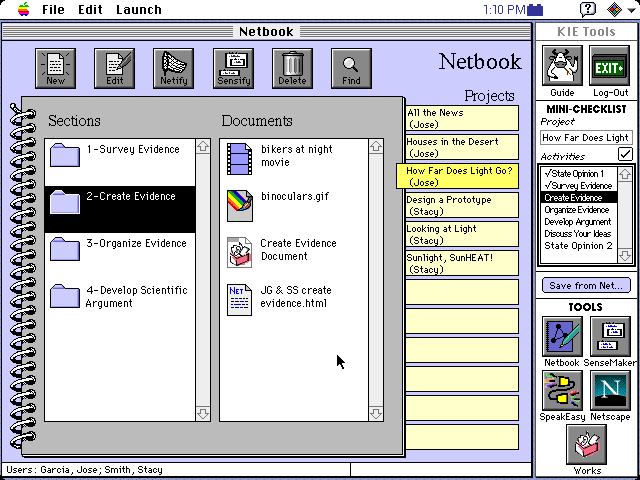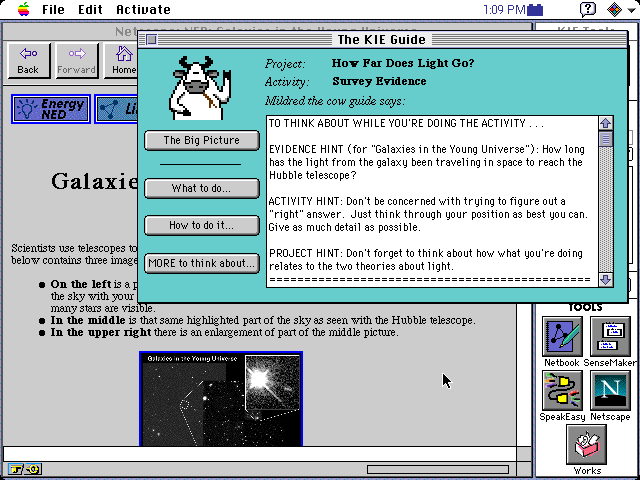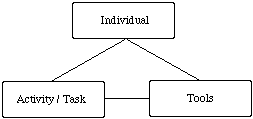

D-Lib Magazine, September 1996

The Web is a tool in search of a metaphor. The Knowledge Integration Environment (KIE) Project offers a promising view of the Net as a resource for lifelong learning and knowledge integration. Everyone from computer scientists to the proverbial "person on the street" senses great possibility in the large scale conversion of information to digital formats accessible over networks. Education is often held up as a prime beneficiary of digital libraries. However, the obvious benefits, such as distance education or literally global text search, fall short of justifying either the lofty expectations for an educational revolution or the enormous costs of putting everything on-line. Like most technological innovations, we must focus not only on how tools help us with the same old tasks, but how the nature of the task itself may be changed. Indeed, truly revolutionary technology sometimes changes the nature of the user as well. This is precisely the goal of education, to change the "user" -- to broaden the mind of a student.
In this paper, we describe how the KIE project takes advantage of digital libraries when on-line information and resources are carefully wedded to learning activities. We believe it is this brokerage of content and activity, informed by cognitive research, that provides significant insights into learning using digital libraries. Additionally, due to the heightened variability in the quality and credibility of on-line information, an electronic textbook metaphor will not suffice for on-line education. Students should be engaged in activities which help them discriminate between competing information resources. In addition to becoming critics of information, students also need to learn how to become effective authors in the digital arena.
In the past, technologists have focused on improving and expanding information delivery, access, and retrieval. The KIE research group has spent the last two years designing ways for students to use the Web for science learning. Building on the results of over eleven years of education research in using technology to help students actively learn, our group works primarily on understanding student cognition and how learning may be scaffolded using technology. We have encountered many of the same issues that confront digital library developers, but our education- and psychology-oriented perspective has given us insights that have fundamentally changed the way we design our technology.
Our group has developed the Scaffolded Knowledge Integration framework to guide our design of instructional technology (Linn, 1995). The SKI framework emphasizes: (a) cognitive goals for instruction where "less is more" and where students are encouraged to connect their scientific ideas to their own life experiences, (b) autonomy on the part of students as they conduct their investigations and critiques, (c) scientific thinking made visible to students through computer representations and classroom practices, and (d) social supports during instruction so that students benefit from being actively involved in the classroom setting.
Our research project is charged to improve precollege science education through effective uses of the World-Wide-Web and the Internet (Bell, Davis, & Linn, 1995). Our approach is based on critique, interpretation, and application of scientific evidence to real world questions and problems. Students use the KIE environment to do projects, making use of Web-based "evidence," some scientific and some not. Often the product of collaboration between practicing scientists and teachers, these projects help students explore an area of science in a way that is relevant to their own lives. For example, students may be asked to critique an argument someone is making about how to keep cool in the summertime, or they may be learning about particulate air pollution and collecting relevant data in their own community.
Our software both organizes student work and provides structure to help students learn. Figure 1 shows what a student would see as they work on a KIE project. The tool palette to the right is always available. It provides a visible reminder of the steps making up the project and allows access to the software used in KIE. This includes commercial applications including a Web browser and a Web-capable editor. Students use custom KIE software to organize their project files, analyze evidence, and publish on the Web. Additionally, the system can provide context-sensitive guidance on demand. The guidance provided is specific to each student's own progress in the project. For each piece of evidence on the Web that students investigate, they can receive guidance developed especially for helping them understand its salient aspects.

We provide two library-like Web-based resources for the students to use in the course of their projects. The first is the Networked Evidence Database (NED), a pedagogically-cataloged index into science information on the Web. The second is the SpeakEasy discussion software, a structured multimedia discussion tool. Each of these resources challenges the notion of Web as a static repository.
We started with a naive view of the NED, in which we would simply store a database of scientific evidence which had been put on the Web. Rapidly we discovered problems familiar to librarians. How should we catalog the information? Should we use a taxonomy, keywords, or other types of indices? Further questions arose relating to science: What should count as "evidence?" Should we treat ourselves as editors -- judging quality, reliability, or relevance of information? How can we provide support for the broad variety of students expected to work with this evidence? Lastly, we grappled with questions about curriculum and evidence. We have attempted to create courseware in decomposable, reusable pieces, and this is a continuing area of emphasis. Serious technical issues depend on these issues. For example, should all hints and guidance for a piece of evidence be dependent on the project in which it is used?

In the end, NED evolved to be a compromise between a catalog and a collection, and its elements are a compromise between pieces which stand alone and pieces tailored to a particular project (see Figure 2). Our current NED collection includes evidence from physics, paleontology, astronomy, Earth science, and biology. The following is a piece of evidence from a project where students are applying their knowledge of thermodynamics to design a house for a desert setting:
 The Straw Bale House Evidence
The Straw Bale House Evidence

In considering the presentation of information to a students, a teacher must not only consider the value of the information, but also its suitability to the individual and the activity they are to complete. Accordingly, NED is structured to allow teachers access to this type of information. Each entry includes information about what projects the evidence has been used with in the past, the rationale for presenting it to students, in addition to more traditional information such as suitable age levels, length, content areas, author, title, format, etc. Indeed, some companies are beginning to index textbooks and curricular materials in this way, with pointers to state education frameworks and potential uses.
Classroom research continues to inform the structure of the evidence database such that it meets our pedagogical goals. Briefly, our NED research efforts have focused on the following areas:
This research on how students make use of on-line information has informed the design of the KIE projects. We are also designing software tools which complement on-line resources like NED based on this research. The SenseMaker software supports students as they browse, annotate, and construct arguments for a set of evidence items relating to a particular KIE project. Figure 3 shows a sample student argument from a debate project on the nature of light. SenseMaker provides a means for students to express and refine their scientific ideas about disparate information on the Web.

In KIE, students often use a public forum to exchange these personal perspectives and to further explore a range of theoretical possibilities. One approach we've been exploring is to have students engage in discussion on-line using our SpeakEasy discussion tool.
Passive information transfer is of little value if students just memorize the instructional materials. Constructivist educational theory describes the importance of students as active learners. One of the primary ways this is accomplished is through collaborative learning and community knowledge-building, where students can share and refine their ideas with others. The SpeakEasy discussion tool is a component of KIE that allows students, teachers, and scientists to talk with each other over the Web (Hoadley, Hsi, & Berman, 1995). The tool scaffolds students to help them generate a more productive discussion.
As Don Norman and others have documented, the design of interfaces influences their use. This is nowhere more important than when designing tools to engage students in learning through discussion, since group discussions or collaborative learning can sometimes engage students and foster reflective learning, but can sometimes stifle or even traumatize students. The SpeakEasy uses written text and the categorization of comments to encourage students to reflect on their ideas as shown in Figure 4.

Importantly, the SpeakEasy structures information not only topically, but socially. All comments are represented by icons of their author's face. Individuals are encouraged to input overviews of their own opinions on a topic, which others may browse to get a sense of the conversation's participants. In another area, individuals can have a traditional back-and-forth discussion. However, unlike off-line discussions and many computer-mediated communication systems, users may respond to any prior messages. The structure is displayed graphically. Combining categories and the graphical representation allows students to quickly identify who is talking with whom, whether they are agreeing or disagreeing, and the general flow of the conversation.
In addition, the system is semi-synchronous, designed for use over a wide variety of time scales. On the one hand, students can use the system synchronously; updates to the conversations appear whenever the student navigates. On the other hand, the student conversations evolve into long-term artifacts. A back-end database allows full-text search on all comments, displaying them in their original context. The database also allows similarity-based searches. A student might be presented with comments similar to theirs when adding a comment, or might search for comments similar to theirs in another discussion. This allows past discussions to be used more as a hypertext archive or knowledge base.
 SpeakEasy
Demonstration
SpeakEasy
Demonstration

This combination of structuring Web pages based on "content" (through keywords or topics) and "context" (e.g. social group who produced it, discussion that gave rise to the ideas) may prove to be one of the most important features digital libraries could offer. Currently, traditional libraries and social networks coexist, but are not the same, intersecting primarily through authors' names. In the future, these information networks and social networks may be more deeply integrated, allowing us not only to follow our favorite author, but trace works that have influenced him or her, institutions that an individual participates in, and so on.
We believe digital libraries need to be considered from the vantage point of the content and functionality they are providing as well as the context of the activities they are intended to support. As suggested by the activity theory school of psychology, behavior is not merely a product of individuals and tools, but tasks or settings as well (see Figure 5).

As complex resources are designed and developed for education in particular, careful research on how students learn using such resources should inform the construction of these digital collections. If such pedagogically-structured resources are made available, students will learn how to decipher, judge, apply, and learn from these digital collections. In terms of significant lifelong learning, such knowledge will serve the students well.
The research described in this paper is the result of a collaborative effort. We would like to acknowledge the contributions of the rest of the KIE Research Group: Marcia Linn, Steve Adams, Alex Cuthbert, Doug Clark, Elizabeth A. Davis, Sherry Hsi, Doug Kirkpatrick, Jim Slotta, and Judy Stern.
This material is based upon research supported by the National Science Foundation under grant No. RED-9453861. Any opinions, findings, and conclusions or recommendations expressed in this publication are those of the authors and do not necessarily reflect the view of the National Science Foundation.
Bell, P., Davis, E. A., & Linn, M. C. (1995). The knowledge integration environment: Theory and design. In J. L. Schnase & E. L. Cunnius (Eds.), Proceedings of Computer Support for Collaborative Learning '95 (pp. 14-21). Mahwah, NJ: Lawrence Erlbaum Associates.
Hoadley, C. M., Hsi, S., and Berman, B. P. (1995). Networked multimedia for communication and collaboration. Paper presented at the Annual Meeting of the American Educational Research Association, San Francisco, California, April, 1995.
Linn, M. C. (1995). Designing computer learning environments for engineering and computer science: The scaffolded knowledge integration framework. Journal of Science Education and Technology, 4(2), 103-126.


hdl://cnri.dlib/september96-hoadley